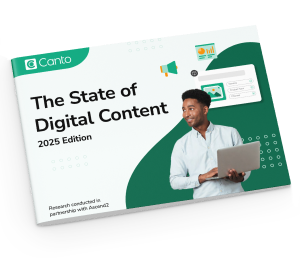How to choose a digital asset management system: A practical guide
| July 17, 2025

Choosing the right digital asset management (DAM) system is a strategic decision that sets the foundation for how your team creates, manages, and delivers content. The best DAM platforms empower creative and marketing teams to move faster, collaborate more easily, and maximize content ROI.
In this guide, we’ll walk through how to choose a digital asset management system that fits your unique needs, goals, and workflows – with practical steps to evaluate platforms, compare DAM vendors, and confidently select the right partner.
1. Define your DAM must-haves
First, get clear on what matters most to your team. Every DAM buyer wants better organization and faster access to files, but choosing the right DAM software depends on understanding how your team actually works. Here’s a roadmap for identifying your team’s essential needs:
Identify your top priorities
Are you trying to move faster? Protect your brand? Prove content ROI? If you’re not sure, here are some common priorities:
- Brand consistency across teams and markets
- Productivity gains for creative and marketing teams
- Secure, streamlined sharing with external partners
- Content usage analytics for performance insights
- Compliance and protecting copyright / sensitive assets
Map your team’s workflows and pain points
Start where the pain is. These problems are exactly where a DAM system can unlock major marketing efficiency. Consider common issues like:
- Assets are hard to find
- Duplicates live in too many places
- Collaborating across teams is slow and manual
- No centralized place for version control or approvals
- Managing content across dozens of tools and platforms
Consider future needs
As your business scales, your DAM platform should, too. Think about what your team might need in the future, like:
- Adding new users, brands, or markets
- Expanding asset types (video, UGC, etc.)
- Supporting hybrid or global teams
- Growing your content volume year over year
Look for DAM vendors staying ahead of the curve that are investing in AI, automation, and content operations tools that can help you scale. That’s where you’ll unlock true digital asset management ROI that leadership will love.
Get internal buy-in from key stakeholders
Bring all the essential players to the table early. This will help streamline the buying process later and ensure smooth adoption across your organization.
- Marketing and creative leads: The primary users who need a system that fits their workflow
- Brand managers: To ensure brand consistency and content governance are maintained
- IT team: For input on integrations, infrastructure, and security requirements
- Procurements or finance: To align on budget, licensing, and pricing structure
- Digital asset manager or librarian: If you have a dedicated DAM role, involve them early, or consider hiring one to support long-term management
- Executive sponsor (CMO, VP of marketing, etc.): To help drive adoption and align the investment with broader business goals

2. Know what features drive value
A long list of features might sound impressive, but smart DAM buyers focus on how these features solve real problems and drive business outcomes. Let’s take a look at the top benefits of digital asset management and the features that enable them.
Find what you need, fast
If your team wastes time digging through folders, recreating assets, or asking “Do we already have this?”, your DAM system need to prioritize discoverability. A best-in-class DAM platform doesn’t just reduce time-consuming metadata management; it streamlines how your team searches, helping you retrieve the right file instantly.
Look for features like:
- AI-powered search
- Auto-tagging
- AI face recognition and text extraction
Protect brand consistency
Your brand is only as strong as your brand management strategy. If assets are off-brand, outdated, or misused, you risk eroding trust – internally and externally. Look for tools that make the right content easy to use and the wrong content hard to reach, like:
- Version control
- Built-in approval workflows
- Style guides
- Brand templates
- User permissions
- Digital rights management (DRM)
These DAM features keep everyone aligned, whether you’re managing two users or two hundred.
Streamline collaboration and delivery
Today’s content workflows span teams, tools, and sometimes continents. If collaboration lives in email threads or disconnected platforms, it’s costing you time and clarity. The right DAM simplifies how digital assets move from brief to distribution, with features like:
- Automated digital asset management workflows
- Integrations with tools you already use
- Brand portals for internal and external sharing
Content scaling without slowing down
As content demands grow, your DAM system should help you move faster, not just store more. Look for DAM systems that automate and accelerate key workflows to support content scaling without sacrificing control or speed. Prioritize platforms that offer:
- AI-powered content discovery
- Automated delivery capabilities
- Asset transformation features like auto-resizing and format conversion
- Flexible permissions and governance frameworks
3. Evaluate DAM vendors strategically
Once you know what you need, it’s time to compare your options. But don’t get stuck in demo fatigue – evaluate vendors against your specific goals.
Shortlist platforms based on your priorities
Look for vendors who:
- Serve companies like yours
- Are built for your use case (creative, marketing, sales, or all three!)
- Offer customer support that meets your standards
What to look for in demos and free trials
Come prepared and request personalized demos. Have a short list of “must haves” and “nice to haves.” Ask to see:
- Search functionality
- Your actual workflows in action
- Onboarding process
- Delivery functionality
How to assess UI, reliability, and efficiency
A great DAM platform is one your team will actually use. Look for:
- Clean, intuitive interface
- Responsive load times and uptime
- Mobile and remote access
- Role-based permissions
Bonus: Ask how long digital asset management implementation typically takes and how they support adoption.
Evaluating pricing structure and features
Not all DAM packages are created equal, and comparing them based on price alone can lead to costly trade-offs down the road. Instead of price shopping, focus on value shopping. What are you really getting for the cost? Make sure you evaluate:
- Seat based vs. storage-based pricing: Some platforms charge by user, others by storage, and some by both. Know which digital asset management pricing model aligns better with your team’s growth plans and digital assets volume.
- What’s included vs. what’s an add on: Some features are included and others are an additional cost. Ask vendors to break down exactly what’s included at each tier and evaluate against your needs.
- Support, training, and upgrades: Don’t assume these are baked in. Some vendors charge extra for implementation or tiered support options. A cheaper plan with zero support is rarely a good deal.
A DAM system is a long-term investment that can significantly boost content ROI if done right – your pricing evaluation should reflect that.

4. Make the right call with confidence
After all the research, it’s decision time. Avoid analysis paralysis by using a clear framework to make your choice and feel great about it.
- Use a scorecard or decision matrix: Rate vendors against your defined priorities, like ease of use, key features, support, cost, etc.
- Align internally before purchase: Confirm budget, get stakeholder buy-in (i.e., overcome any leadership objections), and ensure team alignment before you sign on the dotted line.
- Pilot with a small group, then scale: Test with power users or a single department before rolling out across your organization.
- Don’t just buy a tool –choose a strategic partner: The best DAM vendors don’t disappear after onboarding. They evolve with your business and help you unlock ongoing value.
Canto: The DAM platform helping modern teams work smarter
As you’ve seen, choosing a DAM system isn’t just about features. It’s about finding the right partner to support your content lifecycle, your team’s workflows, and you company’s growth.
Here’s why top teams choose Canto DAM:
- Built for marketing and creative teams: Canto is purpose-built with an intuitive UI that empowers teams to manage assets without friction.
- Fast, intelligent content discovery: AI Visual Search, Smart Tags, facial recognition, and text extraction make finding content fast and foolproof.
- Controlled, customizable sharing: Unlimited Brand Portals and advanced permissions ensure you can deliver content to any audience, without sacrificing control.
- Workflows that scale with you: From collaborative editing to automated approvals and 40+ integrations, Canto supports your full content lifecycle as you grow.
- Real, ongoing support: Best-in-class onboarding and a combination of smart AI and live support from real people mean you never get stuck.
- Optional PIM integration: For brands managing both content and product data, Canto PIM keeps everything connected and accessible.
See why Canto is the DAM of choice for top teams looking to maximize content ROI.

